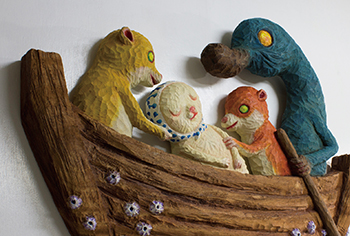 2014 9.12 - 10.11
2014 9.12 - 10.11

Installation >>
Opening Reception
9.12 (Fri.) 18:00 - 20:00
Place:nca | nichido contemporary art
Date:Fri 12th September – Sat 11th October 2014
Gallery Open:Tue – Sat 11:00 – 19:00 (Closed on Sun, Mon and national holidays)
Opening reception: Friday 12th September 18:00 – 20:00
Supported by TURNER COLOUR WORKS LTD.
nca | nichido contemporary art is pleased to present a solo exhibition of new works by Japanese Artist, Takanori Ishizuka.
In the works of Takanori Ishizuka there appear, one after another, small adorable yet bizarre creatures that are full of life with their vivid and varied facial expressions. They are strongly influenced by Japanese mythologies, folklore, as well as satirical caricatures and woodblock prints, in which the artist is interested. On behalf of Ishizuka, the anthropomorphized animals communicate the world that surrounds the artist and his feelings.
This exhibition showcases paintings, the medium of expression, which forms the point of origin for Ishizuka’s artistic production, reliefs that combine painting with three-dimensional (wood carving) expression, and video works.
Totem Arcadia
Many have mentioned that Takanori Ishizuka’s works, which are created by coloring woodcarvings, remind them of “totem poles” made by the indigenous people living in the coasts facing onto the Pacific in North America. The fact that Ishizuka often carves out animals is probably part of the reason for this. Moreover, the mood of primitive autochtonousness that predates the appearance of human beings, exacerbated by the bulging eyes and the peculiar things coming out of some creatures’ mouths, contributes to the fact the works are seen as something occult.
It is said that totem poles existed fundamentally as house posts, as a primary pillar in a house, but they also represented the history and the family emblem, and even functioned as way of shaming at times. The word “totem” too has an intriguing meaning—the symbol of wild animals and plants that are religiously linked to the tribe or blood ties—which is closely reminiscent of the nature worship and ancient Shinto in Japan. As such, it is perhaps not surprising that Ishizuka’s works remind us of totem poles.
I feel as though the way we think about life in relation to our family or animals—what Ishizuka has been expressing through his works—has significantly changed in Japan after March 11, 2011.
It seems that each of us, not just those who directly suffered the damage of the disaster, has begun to reexamine our lives, prompted in part by the issues related to the nuclear power plants in Fukushima, embarking on a path to “regeneration.” Many artists tormented over the question “is there any point in creating different forms of art such as poetry and painting after Sanriku and Fukushima?” and were brought to a standstill in their contemplation. There has been much discussion about this issue in the past, as with Theodor Adorno and Maurice Blanchot, but what has proved important over the ages is the fact that human beings are a species that continues to stand up against major calamities. That recognition permeates Japan now, reaching everyone, including those who create works of artistic expression.
It appears as though Ishizuka has begun to deliberate about how life has been passed on to him, and how he may pass it on to his children and grandchildren, after becoming a father. This is palpable in his use of color and in each and every line that is carved into the wood. I was told that in this exhibition Ishizuka will present the “story of the beginning” as he understands it. Looking at posters and advertising on TV, Japanese media is noticeably brimming with messages such as “Live!” “Don’t die” or “We must live.” My honest wish is to see an image that delivers a deep blow inside us, rather than those kinds of messages. When Ishizuka became a husband and then a father, and began to create his art not for himself but as a hope directed towards others, the totems must have become Arcadia. What I want to witness is the confluence of the ancient flow of indigenousness and the honest feelings he harbors now. I refer to that small light that is seen when various calamities and difficulties have been overcome. I am hoping to see what lies beyond the cadavers of the creatures he has painted in the past.
Yumi Yamaguchi
<Takanori Ishizuka>
Born in 1970, lives and works in Kanagawa, Japan.
Selected Exhibitions: Odate & Kitaakita Arts Festival 2014, Japan (upcoming), Trans Arts Tokyo, Tokyo (2013/2012), TRAUMARIS, Tokyo (2011), hpgrp window gallery, Tokyo (2010), nca | nichido contemporary art, Tokyo (2009), DISCO, Yokohama, Japan (2006), Little More Gallery, Tokyo (2005), MAKII MASARU FINE ARTS, Tokyo (2005), Tokyo Wonder Site Shibuya, Tokyo (2006), CAFE in Mito 2004, Art Tower Mito, Mito City Museum, Japan (2004)
Collection: MOT Museum of Contemporary Art Tokyo, Public Collections, Private Collections
<Yumi Yamaguchi>
A Tokyo-based art producer and art journalist, as well as the self-appointed “cheerleader” for Japanese Contemporary art. Her website "Tokyo Trash" since 1996 is the oldest art website in Japan. She is also the Director of the Citizens League for the Arts, a special non-profit organization. Yamaguchi was the general producer for the Electric Art Talent Kanazawa (eAT Kanazawa99), a jurist for Ars Electronica 2004 Net Vision in Rinz, TERADA ART AWARD and Golden Competition 2014. She was an executive committee member of 2010 Shanghai Expo Commemorarion Prints Exhibition. Her books: "The introductory Introduction to Contemporary Art" "Art Tourism" (Kobunsha), "Warriors of Art: Contemporary Art in Japan" (Kodansha International) and more.